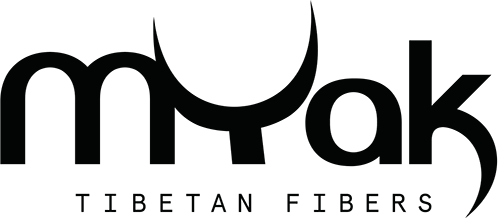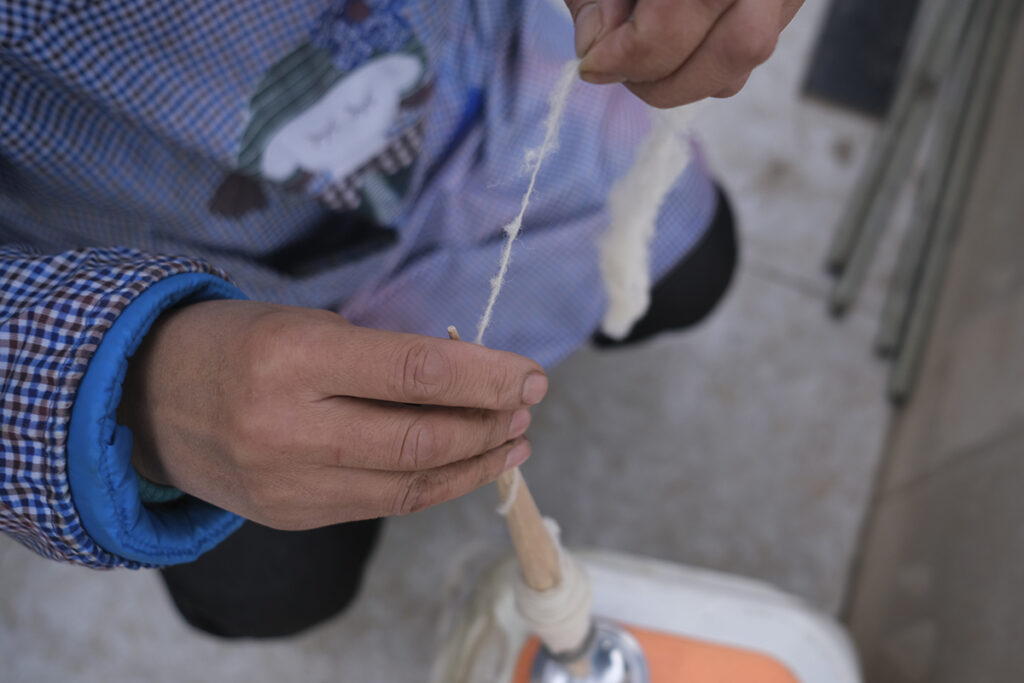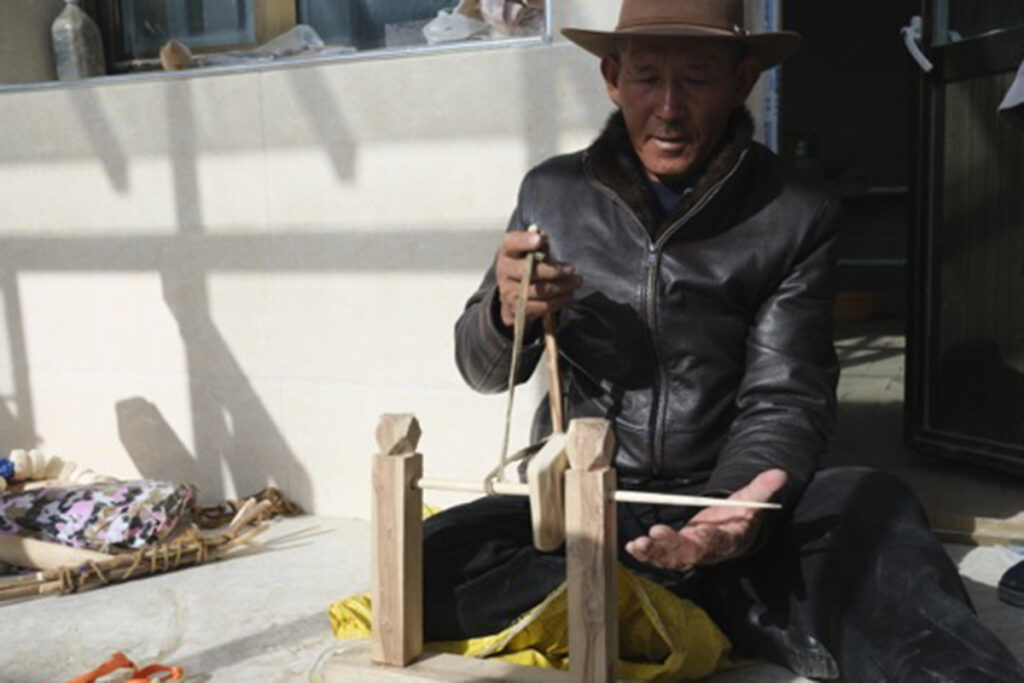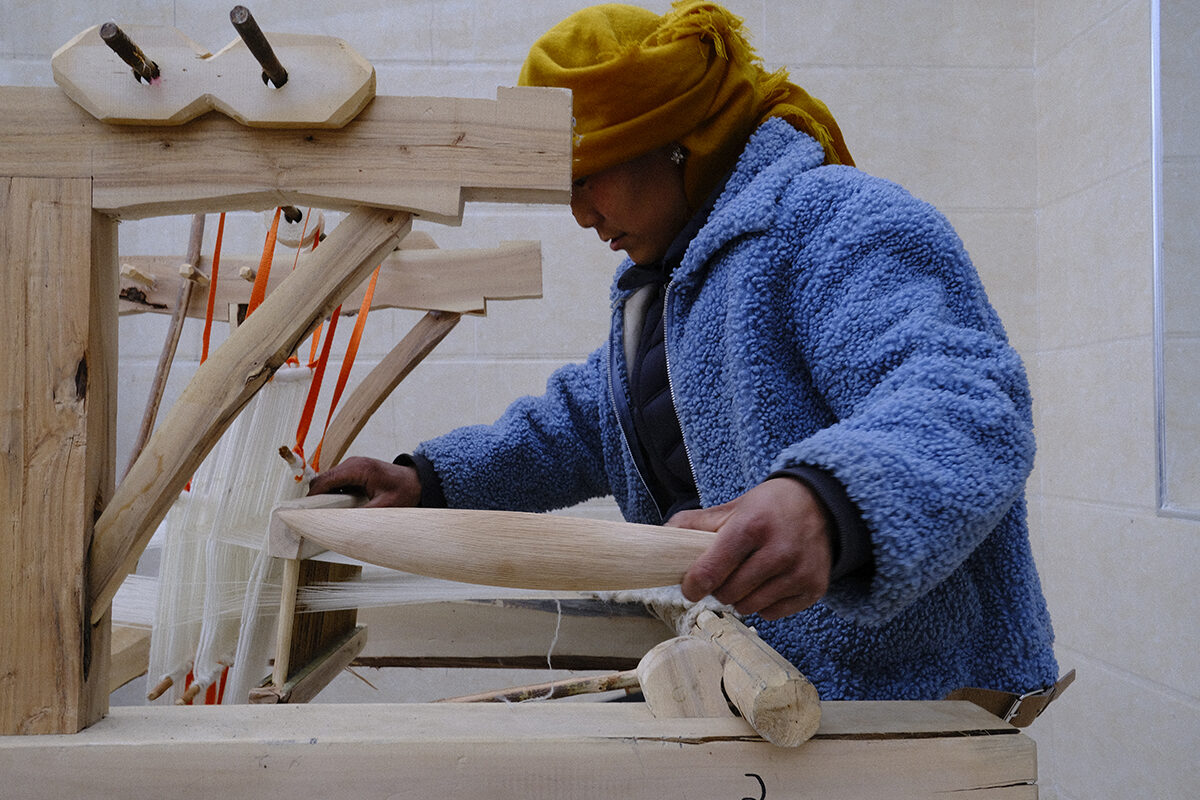
would not surprise anyone who has visited a Tibetan home or monastery. One of the most essential and prized items for farmer, nomad, monk or aristocrat, the Tibetan woolen rug is possibly the single cultural artifact that serves in all types of dwelling across the plateau, gracing adobe-floored rooms, the ground under a yak-hair tent, warming the hearth and soul of those sturdy folk living on the vast grassland of the Tibetan Northern plains, where temperatures drop well below freezing, or making comfortable the inhabitants of the fertile river valleys of the south and east.
The early nomadic hunting tribes could have not survived without a rudimentary method of weaving textiles for making garments and tents. This explains the unique weaving technique found on the Plateau. Those ancient techniques evolved over the centuries and were also influenced by neighboring cultures. Until only a few years ago, it was very common to see traditional looms that could be easily assembled on the summer pasture with which women would use the coarse hair of the yaks to weave the panels for black tents, a tradition that had been carried forward for over 1,300 years.
By the mid-seventh century, Tibet had mastered the skill of producing a finely woven textile used for their garments called nambu . The Tibetan traditional full-length over-garment known as chuba, well-suited for the extremely frigid Tibetan winters, is typically made of nambu and adorned with silk brocade.
Nowadays those beautiful sturdy tents and traditional textiles are harder to find; the tents in many areas have been substituted by cheaper plastic ones, and synthetic textiles are now common.
in a particularly rural area of the Tibetan Plateau, starting off with a small group of local women, and slowly expanding the operation to include a larger community. We selected the target area and identified a local partner with whom we can work closely. While the textile traditions in this area have been lost, women still spin and weave with rudimentary tools that produce a very basic fabric.
Our aim is to create a small-scale textile chain from animal breeding to fiber collection, spinning, natural dyeing, weaving, and finishing, all on the Tibetan Plateau, creating a Made By Tibetans label.
is the name selected for our textile lab by the local community of Erthi Village.
It means white peak, the snowy mountain that for Tibetans represents a good omen for the future. Traditionally, Tibetans offer guests a khatak, a white scarf, which symbolizes pure intention, and a wish for good fortune. So too do we intitiate Dokarpo, imbued with the same intent for good and auspiciousness as the steadfast and ancient snow mountains.
The target area is a village named Erthi in Hainan Prefecture, Qinghai Province, in an area totally outside the usual tourist circuit.
The area is very arid and not suitable for any agricultural activity, only the Tibetan sheep and a few yaks can survive in these poor pastures.
We think that the best way to maintain their presence in their traditional areas is to create sustainable income producing activates on the plateau.
The best way to collaborate with them is partnering with them providing the know-how and supporting them to go to market.
The area we selected is populated by both farmer and nomads, is very poor and is located in the southern part of Kokonor lake, where women still hand spin and wave sheep wool.
They mainly raise a Tibetan sheep breed that compared to the Mongolian sheep, very common in Qinghai, has a much better-quality wool.
We are really happy to announce that despite the difficult context due to the pandemic this dream of ours is finally a reality thank you to your amazing support and Dokarpo is now a reality.
We have reached our fundraising goal through different channels and raised a total of $47,972
through a Go Fund me Campaign , funds donated by UK designer Marie Wallin and the two auctions we run on our dedicated Instagram account @myakbeyondborders .
The auctions featured original knitwear pieces donated by Julie Hoover, Michele Wang, Lori Versaci as well as items donated by Joji Locatelli, mYak, PinkHazel and LolaBeanYarnCo.
In March 2021 the project officially started and our team has been present on site to monitor the progress together with our partner and friend Tashi Phuntsok , a young Tibetan entrepreneur with a great love and respect for his culture.



The workshop has been set up in Erthi, a small village located in a quite arid and poor grassland in Hainan prefecture near Chabcha. In a traditional Tibetan courtyard house that belong to Tashi Phuntsok’s family, the “veranda” has been organized to host the looms which have been put near the windows in order to get more light and heat.
The textile workshop has been equipped with four looms, three spinning wheels and washing and dyeing equipment.
The standing looms have been purchased in Lhasa, to substitute the rudiamental floor looks that had been used until now . These new looms, while still traditional are much more comfortable to work with and allow for a variety of patterns.
Women in this area, and across the Plateu, traditionally spin with a spindle, a technique that takes really a longtime: about 4 days for 1 kg of yarn. Using spinning wheels we can still obtain a hand spun yarn but with a much even and faster production.
There was an ancient tradition of dying cloth using local plants and minerals and we are trying to revive it. Since the local know-how in this field is really poor we think that the best solution could be to have a Natural Dyes Expert Trainer that can set up a little space to dye only using local natural ingredients. This step has not yet started.
To date, we have organized two training with a skilled Tibetan weaver who came all the way from Lhasa. He has an incredible know-how that is really important to keep tapping on for future training as finding people that have the necessary skills is really hard.
During the training the team worked on the entire wool processing chain, from raw wool to final product.
The Tibetan women who before the training just had very little experience on their rudimental looms are now fully independent in all the steps.
Clearly there is a lot of practice still to do and other training to reach a high level of specialization, but the pieces that they have produced so far are a wonderful expression of what can be achieved with passion and commitment.
The Dokarpo Wolly Lab so far has produced table sets and runners with a simple design. But even if they are simple, we are really proud of this first production.
The direct beneficiaries of the project are the member of the local team, their families and the families of the shepherds from whom we buy the wool: for now, there are 15 families.
The indirect beneficiaries are represented by the people that live in Erthi as in the near future will benefit from the valorization of a territory that right now is totally marginal.
We are working on marketing and communication activity to see how we can bring these products to market; we are working on design and developing new product idea while refining the existing one with further training to improve both the design and the technical skills. Lastly, but not less important, we are working on the creation of a local company to ensure total autonomy and sustainability.